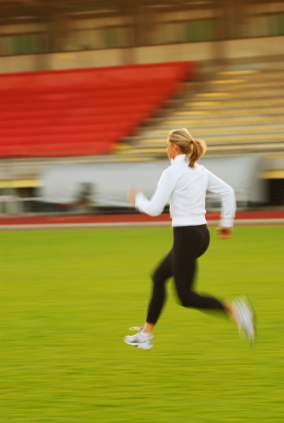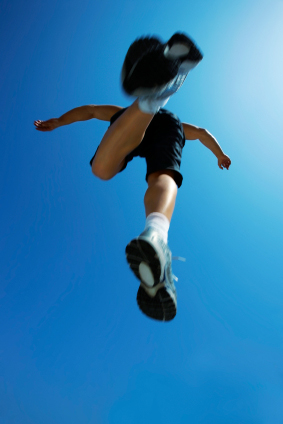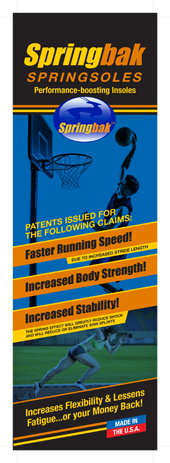Archive for Injury Prevention
Springbak Running Tips – Proper Running Shoes For Your Foot Type
Posted by: | CommentsJogging gained enormous popularity in the 1970s as a great form of cardiovascular fitness. Since then running has become one of the most popular form of physical fitness in America. Whether you run on an indoor track or outdoors, you can enjoy this activity year-round and fit it comfortably into your daily routine.
 Springbak sponsors many Division I Track and Field programs with high-performance footwear for runners. Our patented Springsoles lengthen your stride length and increase stride frequency, and coaches and trainers endorse our product.
Springbak sponsors many Division I Track and Field programs with high-performance footwear for runners. Our patented Springsoles lengthen your stride length and increase stride frequency, and coaches and trainers endorse our product.
During jogging or running, the 26 bones, 33 joints, 112 ligaments, and a network of tendons, nerves, and blood vessels that make up the foot all work together. That’s why you need to condition your body, build up to a routine, and stretch your muscles, tendons, and ligaments before and after each run. Debilitating muscle strain or more serious injury can result when runners or joggers don’t build up their routines and allow their bodies to strengthen over time.
The most common foot problems associated with jogging or running are: blisters, corns, calluses, Athlete’s Foot, shin splints, Achilles tendonitis, and plantar fasciitis. You can prevent many simple foot problems by using proper foot hygiene. Keep your feet powdered and dry. Wear clean socks every time you run. Make sure your shoes fit properly. Most importantly, let your body be your guide so that you don’t overstrain your legs, ankles, and feet. Always wear Springbak Springsoles in your running or training shoes, these increase athletic performance and give you a competitive edge. At the same time, the Springsoles are a highly effective tool for injury prevention, and great for shin splint problems as well.
Jogging/Running Shoes
Because of the force placed on your legs, ankles, and feet, jogging/running shoes need to provide cushioning for shock absorption. Like walking shoes, you need to select a pair designed for the shape of your foot and your natural foot structure or inclination.
There are three basic foot types:
Pronators are people with relatively flat feet, caused by low arches, which generally leads to over pronation, or a gait in which the ankle rolls inward excessively. People with this foot type need motion control shoes that offer support for mid-foot. Motion-control shoes are more rigid and built on a straight last. These are generally board-lasted shoes, which have a piece of cardboard running the length of the shoe for greater stability. Look for sturdy uppers for added stability and avoid shoes with a lot of cushioning or highly curved toes. Also look for a reinforced heel counter to maintain foot support and stability.
Supinators are people with high arches, which can lead to under pronation that places too much weight on the outsides of the feet. People with this foot type need stability shoes designed for extra shock absorption and often having a curved or semi-curved last. A slip-lasted shoe is also recommended, because the sewn seam runs the length of the shoe giving it greater flexibility. Also look for shoes that are reinforced around the ankle and heel to stabilize the foot and extra cushioning under the ball of the foot.
People with normal feet can wear any type of running shoe, although a curved last is generally preferred. When you run, your foot rolls quickly from the heel to the toe, with your foot bending at the ball on each step. That’s why it is important for running shoes to have enough flexibility in just the right places. However, to help with shock absorption, you need a little more rigidity to support the middle of the foot. Make sure the heel is low, but slightly wider than a walking shoe to help absorb the initial shock when your heel strikes the ground.
Here are some other important tips for buying a good pair of running shoes:
- Shop at the end of the day when your feet are slightly swollen to get a good fit.
- Try on shoes with the socks you will wear when walking. If you use an orthotic, bring that to the store when you try on shoes as well.
- Have your feet measured standing up and fit your shoes to the larger of your two feet.
- Be sure there is enough room in the toe box for your toes to wiggle and about a half inch between your toes and the end of the shoe
- Take time when shopping to try on different brands and walk around the store in each pair. Be sure to walk on a hard surface, not just on carpeting. Let your foot be the guide to the fit, not the shoe size or style.
- Look for lightweight, breathable materials for greater comfort.
- Run your hand all over and inside the shoes to feel for any seams or catches that might irritate your foot.
- Choose shoes that lace for better foot stability and control.
- Make sure your heel fits snugly and does not tend toward slipping out of the shoe.
- Consider buying two pairs and rotating your wear to give each pair time to breath between runs and extend the life of each pair.
- Replace running or jogging shoes twice year or about every 400 miles.
Please feel free to interact and share running tips by entering your comments below. We want to hear for you too!
We hope you have enjoyed our tips – Be sure to check the Springbak blog for previous tips and articles!
– The Team at Springbak, Inc.
Visit the Official Springbak® Website at www.springbak.net – Peak Performance Springsoles / Insoles – Run Faster, Jump Higher, Lessen Fatigue
Find us on Facebook: www.facebook.com/springbak
Follow us on Twitter: www.twitter.com/springbak
Friend us on MySpace: www.myspace.com/springbak
Tune in on YouTube: www.youtube.com/springbakinc
Springbak Training Tips – Proper Shoe Gear to Prevent Injuries
Posted by: | CommentsHow often do you need to replace your athletic shoes?
More often than you think, according to Utah Jazz team podiatrist Dr. Michael Lowe.
 The use of proper shoe gear has a strong relationship to the performance and stability of foot function within the shoe. Those shoes which compliment foot requirements for stability, flexibility and shock absorption, can greatly aid in the dissemination of stress to foot and leg structure. The use of Springbak Springsoles in your shoes will greatly benefit all athletes for several reasons. The Springsoles have patented technology to reduce shock related injuries and give much more balance and stability to your game! This is the exact reason NCAA and pro athletes use Springbak in their programs.
The use of proper shoe gear has a strong relationship to the performance and stability of foot function within the shoe. Those shoes which compliment foot requirements for stability, flexibility and shock absorption, can greatly aid in the dissemination of stress to foot and leg structure. The use of Springbak Springsoles in your shoes will greatly benefit all athletes for several reasons. The Springsoles have patented technology to reduce shock related injuries and give much more balance and stability to your game! This is the exact reason NCAA and pro athletes use Springbak in their programs.
The amount of stress applied to the shoe gear before replacement with a new shoe also has a profound influence upon protecting the athlete. Most runners are encouraged to replace shoe gear every 350 -500 miles depending upon the size of the runner and his or her running environment. The same should be true of the basketball player. The average runner will spend about 66 hours in running to accumulate 500 miles on a pair of shoes (8 minute per mile pace times 500 miles). The average high school or collegiate athlete will work out easily 72 hours per month. Basketball shoes are now made of the same types of materials, i.e. eva or polyurethane midsole and a harder outer sole material. These materials all have a fatigue factor which greatly influences function of foot and stress delivered to bone and soft tissue structures.
Players in the NBA will rarely use a basketball shoe for longer than 7-10 days before replacing it with a new pair of shoes (expensive). Springbak understands most athletes can’t afford to replace their shoes so often, but don’t skimp on cheap shoes or replacing them as needed. Always have and rotate 2-3 pairs of basketball or running shoes if you are a competitive athlete.
A positive secondary by-product of frequent shoe change is that of a protective influence of shoe gear to foot and ankle stability to external forces. As the shoe is worn over hours of use the leather uppers slowly begin to stretch to the rotational forces applied. Also the midsole material slowly deforms or compresses to repetitive ballistic starting and stopping of play. As these external changes to the shoe continue the rotational movement of the foot within the shoe slowly increases in range of motion. Therefore it can be seen that with newer shoe usage, there will be fewer inversion injuries as compared to injuries due to the lack of support from worn and stretched shoe gear materials which lack the integrity to decelerate foot rotational movement beyond normal positioning.
The use of a high top basketball shoe is still one of the best means for protecting the ankle from inversion sprains. NBA players choose a wide variety of shoe gear styles to play in; 68% of the players utilize a high top shoe, 15% utilize a 3/4 top shoe, and only 10% will use a low top basketball shoe for regular play. Your choice will be tempered by what is available and what properly fits and your athletic budget. DON’T SKIMP HERE!
Article by William Crow – Former Professional Basketball Player and CEO Springbak, Inc.
For more news, tips and information from Springbak:
Visit the Official Springbak® Website at www.springbak.net – Peak Performance Springsoles / Insoles – Run Faster, Jump Higher, Lessen Fatigue
Find us on Facebook: www.facebook.com/springbak
Follow us on Twitter: www.twitter.com/springbak
Friend us on MySpace: www.myspace.com/springbak
Tune in on YouTube: www.youtube.com/springbakinc
Springbak Training Tips: How To Prevent Injury and Improve Performance
Posted by: | Comments Athletes, especially athletes who play sports which require changes of direction and landing from explosive jumps (soccer, basketball, track and volleyball), must train to prevent injury first, and build to improving one’s performance.
Athletes, especially athletes who play sports which require changes of direction and landing from explosive jumps (soccer, basketball, track and volleyball), must train to prevent injury first, and build to improving one’s performance.
Today’s athlete needs to train the lower body for strength and balance and train the core muscles. “Core Training” is a popular buzz-word in the fitness industry and it means different things to different people; however, training the core musculature – the muscles of the abdominal, lower back, hips, pelvis, quadriceps and hamstrings – improve overall strength. For instance, a boxer throws a punch, he used his upper body; however, his power comes from his lower body. The core is the region that transfers the power from the legs through the upper body. With a weak core, the boxers punch lacks power. The same is true of almost every athletic move… just think about that one.
World class athletes, coaches and trainers use Springbak Springsoles in their athletic programs for performance and injury protection. The Springsoles provide you a competitive edge and absorb shock as well. The Springsoles will increase your stride length when you run, and increase your stride frequency (shorten foot plant time) as well as give your game much more balance and stability: What people are saying about Springbak Springsoles.
How can I increase my vertical jump?
We get this question all the time, here’s how:
The best exercises for increasing your vertical jump are squats, lunges and step-ups. These are the best because they are compound movements, which work the knee joint and the hip joint at the same time…Squats are the best exercise an athlete can do for strength if it is performed correctly.
Great tips on lunges:
Lunges are another great body exercise. Once the athlete learns the movement pattern of lunges in different directions-front, backward and side lunges, they can then use weights in the hands for a more intense workout and challenge your neuromuscular system. Also, the athlete can add different elements to the lunge. A simple addition to work the shoulders to use the medicine ball to do a lunge and press. Additionally, a lunge and reach is a good exercise.
Please comment, as we welcome your tips and advice as well.
_____
For more tips and information from Springbak:
Visit the Official Springbak® Website at www.springbak.net
Peak Performance Springsoles / Insoles – Run Faster, Jump Higher, Lessen Fatigue
Find us on Facebook: www.facebook.com/springbak
Follow us on Twitter: www.twitter.com/springbak
Friend us on MySpace: www.myspace.com/springbak
Tune in on YouTube: www.youtube.com/springbakinc
Todd Christensen sets World Record wearing Springbak Springsoles
Posted by: | Comments Todd Christensen – Oakland Raider, 5 time Pro-bowl tight end and current masters track athlete set a new world record in the 60 meter high hurdles wearing Springbak Springsoles.
Todd Christensen – Oakland Raider, 5 time Pro-bowl tight end and current masters track athlete set a new world record in the 60 meter high hurdles wearing Springbak Springsoles.
“As a tight end at 235 pounds I was far from the fastest player in the NFL and even farther from a track sprinter or professional soccer player of my era. This 2009 season while competing in a masters track meet, I set the world record in the 60 meter high hurdles (8.39 seconds) for my 50+ age group. I set that record with Springbak Springsoles in my spikes.”
“In June of this year while at Gold’s Gym, I did a strength test with and without Springbak Springsoles. I pulled off a heavy enough dumbbell I could only do one repetition while doing a one arm overhead press. I rested three minutes, pulled off the same weight and did five repetitions while using the Springbak Springsoles. Please draw your own conclusions!” Todd Christensen
Volleyball Jump Training
Posted by: | CommentsWe hear these techniques from world class athletes and trainers all the time, there must be something here. The most important part of volleyball training is proper training. If an athlete jumps repeatedly with poor technique, they can seriously injure themselves. A good volleyball coach or trainer seems to always emphasize the importance of maintaining proper technique at all times.
When volleyball jump training, athletes should keep their knees directly in line with their ankles and not allow the knees to bend over further, reaching to where they are in line with their toes. This position puts stress on the knee, an already fragile part of the body. If athletes feel that they cannot get low enough in the sit before the jump, they should either widen their feet or lean further forward, allowing their rear to extend further back, while keeping a straight back.
Besides keeping the knees in line with the ankles, athletes should ensure that they are pushing off from the whole foot. Doing so ensures that athletes get full power in their jump and are not killing the height of the jump. When jumping, athletes should strive to leave the floor from the middle of the foot or the ball of the foot for maximum vertical.
Finally, athletes should land by rolling through the foot. This protects the knees and ensures stability as athletes move from jumping into another activity. The best way to land a jump properly is to allow the foot to land naturally in the air, with the toes down. This puts the athlete in the proper  position to land the jump.
position to land the jump.
We want you, the athletes, to give us comments here about your successful routine of volleyball training for proper technique and maximum vertical jumping ability.






















